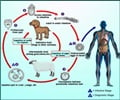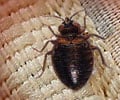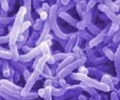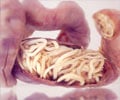Information about Albendazole
Generic Name : AlbendazoleUp-to-date prescription details regarding Albendazole are provided here.
Pronunciation : al-BEN-da-zole
Learn the correct pronunciation of the Albendazole, understand it's uses, recommended dosages, its indications, how to take, when to take, when not to take, side effects, special precautions, warnings and its and its storage instructions.You will also find a list of the medication's International and Indian brand or trade names, as well as its pricing information. For verification of the information presented on this page or for additional clarifications, it's advisable to consult your doctor.
ICD Code : Y41.4 Therapeutic Classification : Antihelmintics
Trade Names/Brand Names of Albendazole
India :
P Worm (10ml) |
Papa A (10ml) |
Kinzol IR |
Teezbend (10ml) |
Diworm (400mg) |
Zend (400mg) |
Hizol (10ml) |
Omnitel (400mg) |
Albenda (400mg) |
Wormtel (10ml) (Vista Healthcare)
International :
Albenza, Eskazole, Zentel, Andazol and Alworm
Why is Albendazole Prescribed? (Indications)
Albendazole is an antihelminthic drug prescribed for treating a variety of parasitic worm infestations such as ascariasis, filariasis or roundworm disease, giardiasis, trichuriasis, pinworm disease, neurocysticercosis, and hydatid disease.It is also used to treat strongyloidiasis, trichinosis, trichostrongyliasis, capillariasis, cutaneous larva migrans, and microsporidiosis including Septata intestinalis infection.
Albendazole works by killing sensitive parasites in the body.
When should Albendazole not be taken? (Contraindications)
Contraindicated in pregnant and breastfeeding women, neonates, patients with known hypersensitivity, and liver impairment.What is the dosage of Albendazole?
Dosing of ALBENZA (albendazole) will vary, depending upon which of the following parasitic infections is being treated.Hydatid cyst disease: PO- Adults >= 60 kg: 400 mg twice daily with meals for 28 days followed by a 14-day drug-free period. Repeat for 2 more cycles. For inoperable hydatid cysts, up to 5 cycles may be given.
Adults < 60 kg: 15 mg/kg/day (not to exceed 800 mg/day) given in two divided doses for 28 days followed by a 14-day drug-free period. Repeat as above. Children >= 6 years: 15 mg/kg/day given in two divided doses for 28 days, followed by a 14-day drug-free period. Repeat as above.
Cysticercosis or neurocysticercosis (larval form of T. solium): PO- Adults >= 60 kg: 400 mg twice daily for 8 - 30 days. Treatment may be repeated as necessary. Adults < 60 kg: 15 mg/kg/day given in two divided doses for 8 - 30 days. Maximum dosage 800 mg/day. Treatment may be repeated as necessary.
Children >= 6 years: 15 mg/kg/day given in two divided doses for 8 - 30 days. Maximum dosage 800 mg/day. Treatment may be repeated as necessary.
Capillariasis: PO- Adults and Children >= 2 years: 200 mg twice daily for 10 days.
Cutaneous larva migrans: PO- Adults: 400mg once daily for 3 days.
Children: 5 mg/kg/day for 3 days.
Giardiasis: PO- Adults: 400 mg once daily for 3 days.
Microsporidiosis including Septata intestinalis infection: PO- Adults: 400 mg twice daily to 1600 mg twice daily has been used. Average dosage 800 mg twice daily. May take up to 2 months to see effect.
Intestinal parasites in immigrants: PO- Adults: 400 mg once daily for 5 days.
Strongyloidiasis or taeniasis † (tapeworm infection): PO- Adults and Children >= 2 years: 400 mg once daily for 3 days. May repeat course in 3 weeks. Children < 2 years: 200 mg once daily for 3 days. May repeat course in 3 weeks.
Trichinosis: PO- Adults: 400 mg twice daily for 15 days.
Trichostrongyliasis: PO- Adults: 400 mg as a single dose.
How should Albendazole be taken?
It comes in a tablet form to take by mouth (orally). Should be taken with food.What are the warnings and precautions for Albendazole?
•Monitor blood counts and liver function.• Patients being treated for neurocysticercosis should receive appropriate steroid and anticonvulsant therapy as required.
• It is important to take iron every day while you are being treated for hookworm infection because it causes anemia.
• Administer within 7 days of start of normal menstruation in women of childbearing age.
• Adequate non-hormonal contraceptive measures must be taken during and for 1 month after therapy.
• Perform liver function tests and blood counts before and every 2 wk during high dose therapy of hydatid disease.
• It may cause bone marrow depression.
• It may cause dizziness. Do not drive or perform other possibly unsafe tasks until you know how you react to it.
• In young children, the tablets should be crushed or chewed and swallowed with glass of water.
What are the side effects of Albendazole?
Central Nervous System- Headache, seizures, confusion, raised intracranial pressure, dizziness/vertigo, signs that meningeal sings.Skin- Reversible hair loss, infection, hypersensitivity including rash and hives, allergic reactions.
Gastrointestinal- Abdominal pain, nausea/vomiting.
Genitourinary- Acute kidney failure, dark urine.
Liver- Abnormal Liver Function Tests, inflammation of liver
Blood- Decrease in the number of white blood cells, thrombocytes, hemoglobin.
Miscellaneous- Fever.












